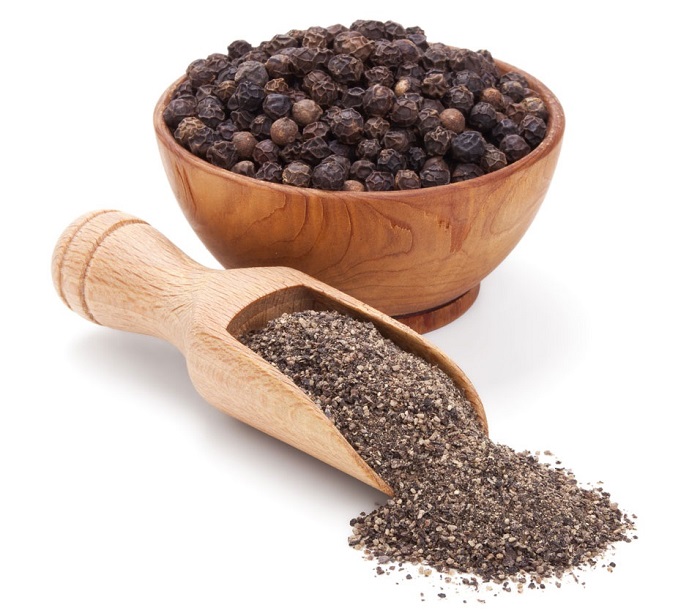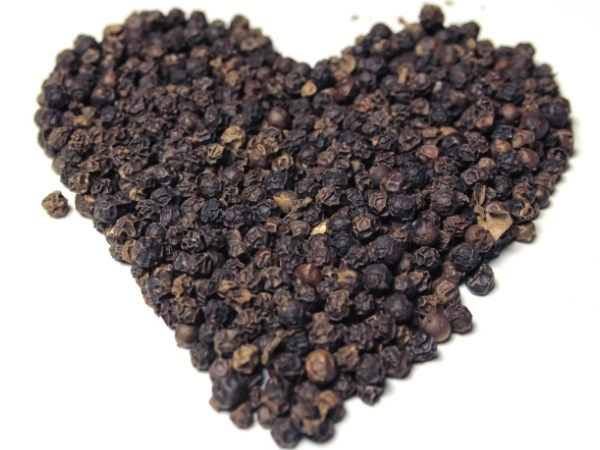Main Name: Black Pepper
Biological Name: Piper nigrum
Names in other languages: Sazonar con pimienta (Spanish), Poivrer (French), Pepř (Czech), Kalimirch (Hindi), Milagu (Tamil), Kurumulaku (Malayalam), Miriyalu (Telugu), Kada Mari (Gujarati), Golmarich (Bengali), Mire (Marathi), Golmaricha (Oriya), Kalimirch (Urdu & Punjabi)
Biological Name: Piper nigrum
Names in other languages: Sazonar con pimienta (Spanish), Poivrer (French), Pepř (Czech), Kalimirch (Hindi), Milagu (Tamil), Kurumulaku (Malayalam), Miriyalu (Telugu), Kada Mari (Gujarati), Golmarich (Bengali), Mire (Marathi), Golmaricha (Oriya), Kalimirch (Urdu & Punjabi)
If you assumed black pepper to just be a spice, which accompanied salt on the dining table, it’s time this spice gets a bit more respect. Apart from being an accompaniment, black pepper adds great taste to your dishes. But note that this is just not it, for this aromatic herb has been blessed with a number of nutritious benefits. A native to tropical Asia, black pepper is one of the oldest known culinary spices in the world. Use it ground or as whole peppercorns, this strong flavored and pungent spice has centuries-long history of usage and cultivation. Often referred to as the “king of spice”, black pepper is a berry obtained from the pepper fruit, belonging to the piperaceae family. Biologically known as Piper nigrum, black peppers are obtained by plucking the berries when half ripe and just about to turn red, and leaving them in the sun to dry until they shrink and turn dark in color. The other varieties of black pepper are green peppers which are picked when they are still unripe and green colored, while the white peppers are picked on turning ripe and soaked in brine to remove their dark black skin and acquire the white pepper seed beneath. So, whether you choose to use it as a table spice or add lots of it in various recipes, black pepper has plenty of health benefits to offer. Listed in the segments below, are some nutrition benefits of black pepper.
History
Known to be discovered more than 4,000 years back along the Malabar Coast of south India, now Kerala, peppercorns are deemed to be the oldest used spices. But, they came into cultivation around 1000 BC. The spice was known in Greece in early 4th century BCE, but since it was rarely known and highly expensive, only the rich could afford it. Though it was grown in southern Thailand and Malaysia too, India was the most important source of black pepper. The Romans, too, were aware of black pepper and opened ocean crossing of the Arabian Sea, after the conquest of Egypt, to reach India’s Malabar Coast. But with the discovery of the new World and Chile peppers, popularity of black pepper declined. After the Middle Ages, black pepper was exported to Europe, the Middle East, and North Africa from India. With the Portuguese influence, black pepper was cultivated in Java, Sunda, Sumatra, Madagascar, Malaysia and other parts of Southeast Asia. However, these areas traded mostly with China or used the spice locally. With the Indian black pepper gaining more popularity, the Portuguese managed to find a sea route to reach India. Vietnam, India and Indonesia are the major producers of black pepper today.
Known to be discovered more than 4,000 years back along the Malabar Coast of south India, now Kerala, peppercorns are deemed to be the oldest used spices. But, they came into cultivation around 1000 BC. The spice was known in Greece in early 4th century BCE, but since it was rarely known and highly expensive, only the rich could afford it. Though it was grown in southern Thailand and Malaysia too, India was the most important source of black pepper. The Romans, too, were aware of black pepper and opened ocean crossing of the Arabian Sea, after the conquest of Egypt, to reach India’s Malabar Coast. But with the discovery of the new World and Chile peppers, popularity of black pepper declined. After the Middle Ages, black pepper was exported to Europe, the Middle East, and North Africa from India. With the Portuguese influence, black pepper was cultivated in Java, Sunda, Sumatra, Madagascar, Malaysia and other parts of Southeast Asia. However, these areas traded mostly with China or used the spice locally. With the Indian black pepper gaining more popularity, the Portuguese managed to find a sea route to reach India. Vietnam, India and Indonesia are the major producers of black pepper today.

http://www.thehomesteadgarden.com/the-spice-series-black-peppercorns-medicinal-benefits/
Health Benefits of Black Pepper
- Amongst all the health benefits of black pepper, the most significant is its ability of improving digestion. By stimulating the taste buds, black pepper increases the secretion of hydrochloric acid, thereby enhancing the digestion process once food reaches your stomach.
- Intestinal gas has often been an embarrassing problem for many. By stimulating hydrochloric acid secretion in the stomach, black pepper works on reducing intestinal gas problems.
- Black pepper is loaded with antioxidant properties which prevent and curtail oxidative stress. Besides, these compounds work to reduce the damage caused by saturated fats, which is regarded as the primary cause of oxidative stress.
- Piperine, a phytochemical found in black pepper, is effective in inhibiting the pro-inflammatory cytokines produced by tumor cells. This, in turn, holds back the signaling mechanisms between cancer cells and decreases the chances of tumor progression.
- The antioxidant properties of black pepper help in preventing and repairing damage caused by free radicals, thereby avoiding the risk of cardiovascular diseases and liver problems.
- Vitiligo is a skin disease that leads to some areas losing its normal pigment, thereby turning white. Black pepper has been proved to be an effective remedy for curing this problem by stimulating the skin to produce pigments. As such, black pepper also acts as a protective agent against the risk of skin cancer that can occur due to excess ultraviolet radiation.
- The outer layer of peppercorns is known to break the fat cells and boost metabolism. Hence, all foods containing considerate amounts of black pepper are an effective way of shedding those unwanted kilos.
- Regular intake of black pepper is known for benefiting people suffering from rheumatism and arthritis. Being warming and stimulating in nature, black pepper improves circulation and provides relief to such patients.
- The spiciness of black pepper helps in clearing congestion and sinusitis. Besides, it aids in relieving coughs and colds.
- Black pepper contains good anti-bacterial properties. Bacterial infections of the mouth, colon, digestive system, urinary tract and others are successfully treated with black pepper.
- Black pepper oil helps in protecting the body from damage caused by oxidants and assists in the repairing process. Besides, it slows down the adverse effects of aging, such as vision loss, macula degeneration, wrinkling of skin, degeneration and loosening of muscles, loss in mobility of joints, nervous disorders and memory loss.
- Black pepper is good for curing tooth ache, tooth decay, earache, gangrene, hernia, hoarseness and insect bites.
Black Pepper Nutrition FactsAmount: 1 cup
Total Weight: 102 g
Total Weight: 102 g
| Nutrients | Amount |
| Basic Components | |
| Protein | 11 g |
| Water | 10.7 g |
| Ash | 4.4 g |
| Phytosterols | 94 mg |
| Calories | |
| Total Calories | 257 |
| Calories From Carbohydrate | 210 |
| Calories From Fat | 28 |
| Calories From Protein | 19 |
| Carbohydrates | |
| Total Carbohydrates | 65 g |
| Dietary Fiber | 26 g |
| Sugar | 655 mg |
| Fats & Fatty Acids | |
| Total Fat | 3.3 g |
| Saturated Fat | 1.4 g |
| Monounsaturated Fat | 757 mg |
| Polyunsaturated Fat | 1 g |
| Omega-3 Fatty Acids | 156 mg |
| Omega-6 Fatty Acids | 711 mg |
| Vitamins | |
| Vitamin A | 560 IU |
| Vitamin E | 1.1 mg |
| Vitamin K | 168 mcg |
| Thiamin | 111 mcg |
| Riboflavin | 184 mcg |
| Niacin | 1.2 mg |
| Vitamin B6 | 298 mcg |
| Folate | 17 mcg |
| Choline | 11.5 mg |
| Betaine | 9.1 mg |
| Minerals | |
| Calcium | 454 mg |
| Iron | 9.9 mg |
| Magnesium | 175 mg |
| Phosphorus | 162 mg |
| Potassium | 1.4 g |
| Sodium | 20 mg |
| Zinc | 1.2 mg |
| Copper | 1.4 mg |
| Manganese | 13 mg |
| Selenium | 5 mcg |
| Fluoride | 35 mcg |

http://healthmeup.com/opinion-healthy-living/healthy-foods-health-benefits-of-black-pepper/23440
How many calories in black pepper (per 100 gm)
Black pepper has about 255 calories per 100 gm of weight.
How to Buy Black Pepper
- Black pepper is available in ground, coarsely ground, cracked and whole peppercorn forms.
- Whole peppercorns are the best choice as they keep their freshness, flavor and essential oils intact for longer durations.
- As for ground pepper, it tends to lose its texture with time and takes on a bitter taste.
- Another alternative to obtain the full flavor is to buy freshly ground black pepper.
- While purchasing whole peppercorns, they should weigh heavy, be compact and free from any kind of blemishes.
Black Pepper Storage Tips
- Whole peppercorns can be stored at room temperature in a sealed container in a cool, dry place for up to one year. However, some sources reveal that whole peppercorns can keep well for up to three years, when stored properly.
- Since ground pepper starts losing its flavor, it is recommended to use it within four months, or as soon as possible to enjoy its flavor to the maximum.
- You can store ground pepper and whole peppercorns in an airtight container in the refrigerator for up to one month, under good conditions.
- Brined peppercorns should be refrigerated once opened and consumed within a month, before they start decaying.
- Water-packed peppercorns have the shortest shelf life after opening. Thus, place them in the refrigerator once opened and use them within one week.

